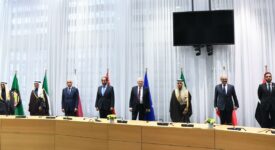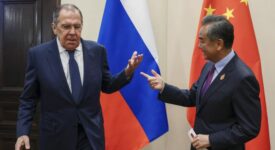Africa was a crucial geopolitical stake during the Cold War, and is once again emerging as a significant area of strategic competition. Thereby, it attracts major non-European powers such as the United States, China, and Russia. Each of them seeks to secure their access to the African theater of operations, through the means of funding and diplomatic agreements, construction of logistical bases, and the sustained exercise of their soft powers. They also conduct military operations on African soil.
As the United States is still primarily engaged in Africa for counter-terrorism purposes, their actions on the ground are significant and coercive. As for China, its main efforts seem to be directed towards peacekeeping operations and plans for the evacuation of its nationals in the event of a crisis. For its part, Russia still restricts its operations to advisory activities. Finally, the three states are actively engaged in military cooperation, not only through arms sales, but also through joint training and exercises with their African partners. While the US is still the dominant player in the African game, China and Russia are now catching up and increasing their involvement.
“The predatory practices pursued by China and Russia stunt economic growth in Africa, threaten the financial independence of African nations, inhibit opportunities for US investment, interfere with US military operations, and pose a significant threat to US national security interests,” President Trump’s national security adviser, John Bolton, presented the new US strategy for Africa in December 2018, resolutely choosing to read the continent’s issues in the light of the new fight between great powers.
This geopolitical vision with the hints of the Cold War is particularly clear in some African countries, such as Djibouti, where a Chinese base was added in 2017 to that of the United States installed in 2002, thus raising palpable tensions. The growth in Russian influence in parts of Africa has been most obvious through the Russian presence in the Central African Republic (CAR) which takes advantage of the weaknesses of the Western presence. As for the US presence, it appears more clearly in Somalia and Libya, where US drones participate in the fight against terrorism alongside local security forces.
These three states closely watch and copy each other, while pursuing a path of their own – partly determined by their resources and partly by different strategic options. Without going so far as to speak of a new “sharing of Africa”, it is at least possible to see the emergence of a sort of “strategic triangle” between these three countries, at least if we focus on their military and security policies.
A military and security policy refers to the way in which a state mobilizes and uses all the resources, means and levers specific to its defense and national security apparatus to achieve set objectives, possibly in connection with a “grand strategy” involving a wider panel of power tools. In fact, such a strategy does not always exist, and when it exists, a strong gap often persists between the ambitions displayed, the resources deployed and the results obtained. Indeed, like any public policy, military and security policies are the product of bureaucratic competitions. Thus, some decisions taken independently of military and security policy – for political, economic or diplomatic reasons – may their interpretation difficult.
This was particularly the case when the White House decided to adopt a travel ban for nationals of Libya, Somalia and Chad, making it very difficult to train soldiers from those countries in the United States. Military and security policies towards Africa in the United States, China and Russia are not necessarily always coherent, rational and logical. They can be rather the product of history, an accumulation of decisions, even “crafts”. Rather than strategy, we will therefore speak more willingly of “strategic postures”, to recall that they may contain a share of vagueness, irrationality or lag effects.
Although it is important to remember that these three powers do not necessarily see African Union countries as a homogeneous group, they give more or less importance to certain regional areas on the continent. The United States, China and Russia share the same ambition: to implement a “strategy of access to African theater”, though in terms of operations, large differences exist.
Washington is now very active, including kinetic operations, in Somalia, Libya and the Sahel, while Beijing is currently focusing on peacekeeping operations, evacuations and maritime operations. Russia’s action is very visible in Africa, particularly because of its private military and security companies (SMSP), but this visibility is not proportional to the real scope of this action, which is very modest. Military-technical cooperation, notably arms sales, training, exercises, is one of the major components of the military and security policies of the three countries. Ultimately, it is thus important to reflect on the possible future evolution of these policies, mainly to see to what extent the American and Chinese military posturing in Africa will co-exist in symbiosis or clash while both powers compete for dominance on the continent.
‘Strategic Competition in Africa: American, Chinese and Russian Military Approaches‘ (‚La compétition stratégique en Afrique: approches militaires américaine, chinoise et russe‘) – Study by Aline Leboeuf – Institut français des relations internationales / IFRI.
The Study can be downloaded here
Article Tags:
Africa · Central African Republic · Chad · China · Donald Trump · Libya · Russia · Somalia · terrorism · United StatesArticle Categories:
THINK-TANK






